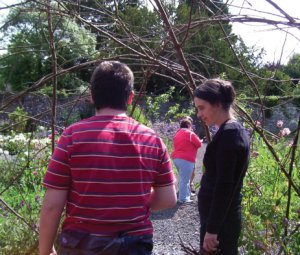Jane Cooke explains how the combination of the natural environment and artistic expression is enriching the lives of adults with learning disabilities living in Powys.

Celf o Gwmpas is a Powys-wide organisation that provides and promotes high quality arts experiences primarily for adults with learning disabilities. Our vision is that art by people with learning disabilities will be recognised as being artistically rich, expressive and valuable. One of the key strands of our work at the moment is art and environment. As an arts organisation we want to be part of the art and environment movement, and working in the disability arena we want to respond to areas of people’s lives that are unexplored.
This theme emerged last year as a result of a combination of factors. As the former Environmental Management System coordinator for Powys County Council, I have become very interested in the environmental art movement, and believe that the artists and environmentalists are possibly the most important people to help us through what will be turbulent times in the next 20-odd years. Furthermore, Powys enjoys the combination of a fantastic natural environment and some very talented environmental artists. We also have the health agenda in the background: the local authority is keen to get people out and about more, as is the Forestry Commission (which wants to improve its levels of social inclusion) so they make good partners for us. All of these together formed a fairly strong imperative to put art and environment into our business plan. Crucially, though, the issue of place, and identity with place, is both important and also largely ignored in the lives of people with learning disabilities. In the past these people were often moved far from their family homes to live in large institutions. Now the pattern of care has changed and once again people have been moved, from the institutions to community-based small group homes in most cases. Any beneficial relationship with the grounds of the institutions, often important in an otherwise bleak life, has been lost. People’s day-to-day lives now concentrate on activities such as shopping, attending college or work placements. Rarely is identifying with and knowledge of place a consideration. This is something that we wish to respond to, not only for the main participants, but also for their support workers and the wider community. Even in a very rural county such as Powys, people can have limited awareness of the environment around them, or of the impacts of environmental change and challenge. The arts organisers who manage our projects and get to know participants very well have also become concerned at the lack of physical fitness of people with learning disabilities: they seem to get driven everywhere, and walking as a leisure activity doesn’t seem to feature – partly to do with living in a rural area, where there is a lack of good public transport. Hand in hand with that is a level of sensory deprivation among people who don’t generally feel the elements, or the exhilaration of a windy day, for example. That is bound to have a negative impact on their creativity. Developing environmental art opens up experiences only available out of doors and surprisingly rarely experienced by our participants: to walk on rough ground, to be in the rain, the sun, the cold. Our work this year has seen many moments of magic as participants develop an artistic awareness of colour, sound or texture. We endeavour to make these opportunities accessible to everyone; we have used a mobile accessible loo on more remote sites and have had funding to provide wet weather clothing. Two projects that we have run this year have taken us forward not only in response to the arts and environment theme, but also in our role of promoting change and influencing others. We want the value and worth of art by people with learning disabilities to be more widely recognised, not least by other artists. Penpont is a country estate on the banks of the river Usk, near Brecon. This year Celf o Gwmpas was part of a residency, and subsequent public exhibition of 13 well-known artists all responding to that environment. Working with environmental artist Morag Colquhoun, participants constructed a willow dome in the centre of the walled garden, growing the plants that formed part of the finished piece and taking some striking photographs, which were turned into postcards also as part of the final exhibition. The Kerry Ridgeway is an old drover’s route high in the Montgomery Hills. This project was designed to resonate with the history of the route; now there is some public art to mark the place, comprising some sheep, a sheep fold and a drover in an area of woodland beside the path and just tantalisingly glimpsed from a public car park. The project was part-funded by the Forestry Commission and Powys County Council’s Countryside and Recreation Department, both of whom want to get more people out into the countryside. We are now developing plans for 2008, concentrating this time on recycling, but not losing site of the importance of place. This will take us, and all of those who work with us into the realm of considering our relationship with the environment and our responsibilities as artists to respond to the growing environmental challenges.
Jane Cooke is Director of Celf O Gwmpas (Arts Round About). t: 01597 822777; e: jane.cooke@celfogwmpas.co.uk; w: http://www.celfogwmpas.co.uk



